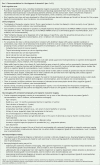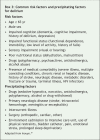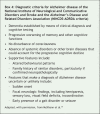Diagnosis and treatment of dementia: 2. Diagnosis
- PMID: 18362376
- PMCID: PMC2267847
- DOI: 10.1503/cmaj.070798
Diagnosis and treatment of dementia: 2. Diagnosis
Abstract
Background: Dementia can now be accurately diagnosed through clinical evaluation, cognitive screening, basic laboratory evaluation and structural imaging. A large number of ancillary techniques are also available to aid in diagnosis, but their role in the armamentarium of family physicians remains controversial. In this article, we provide physicians with practical guidance on the diagnosis of dementia based on recommendations from the Third Canadian Consensus Conference on the Diagnosis and Treatment of Dementia, held in March 2006.
Methods: We developed evidence-based guidelines using systematic literature searches, with specific criteria for study selection and quality assessment, and a clear and transparent decision-making process. We selected studies published from January 1996 to December 2005 that pertained to key diagnostic issues in dementia. We graded the strength of evidence using the criteria of the Canadian Task Force on Preventive Health Care.
Results: Of the 1591 articles we identified on all aspects of dementia diagnosis, 1095 met our inclusion criteria; 620 were deemed to be of good or fair quality. From a synthesis of the evidence in these studies, we made 32 recommendations related to the diagnosis of dementia. There are clinical criteria for diagnosing most forms of dementia. A standard diagnostic evaluation can be performed by family physicians over multiple visits. It involves a clinical history (from patient and caregiver), a physical examination and brief cognitive testing. A list of core laboratory tests is recommended. Structural imaging with computed tomography or magnetic resonance imaging is recommended in selected cases to rule out treatable causes of dementia or to rule in cerebrovascular disease. There is insufficient evidence to recommend routine functional imaging, measurement of biomarkers or neuropsychologic testing.
Interpretation: The diagnosis of dementia remains clinically integrative based on history, physical examination and brief cognitive testing. A number of core laboratory tests are also recommended. Structural neuroimaging is advised in selected cases. Other diagnostic approaches, including functional neuroimaging, neuropsychological testing and measurement of biomarkers, have shown promise but are not yet recommended for routine use by family physicians.
Figures







References
-
- Nasreddine ZS, Phillips NA, Bedirian V. The Montreal Cognitive Assessment, MoCA: a brief screening tool for mild cognitive impairment. J Am Geriatr Soc 2005;53:695-9. - PubMed
-
- Kalbe E, Kessler J, Calabrese P, et al. DemTect: a new, sensitive cognitive screening test to support the diagnosis of mild cognitive impairment and early dementia. Int J Geriatr Psychiatry 2004;19:136-43. - PubMed
-
- Solomon PR, Hirschoft A, Kelly B, et al. A 7 minute neurocognitive screening battery highly sensitive to Alzheimer's disease. Arch Neurol 1998;55:349-55. - PubMed
-
- Brodaty H, Pond D, Kemp NM, et al. The GPCOG: a new screening test for dementia designed for general practice. J Am Geriatr Soc 2002;50:530-4. - PubMed
Publication types
MeSH terms
Substances
LinkOut - more resources
Full Text Sources
Medical
Molecular Biology Databases
Miscellaneous
